- 1,604

- IN
- Eric_J2358
Okay, this thread is for us modders to discuss our thoughts, theories, mod successes and failures, as well as anyone interested in our progress/results. Some of us have been discussing our mods in another thread that shall remain unnamed, but we have been chided for being off-topic. Hence this new thread.
Personally, I have had 2 separate incidents of FFB motor failure in my CSR Elites since I received my first in August 2012. The OEM FFB motors are Mabuchi RS555PH designation, and Fanatec has said that they received a bad batch of motors and that is why they're burning out quite often (the "quite often" is my opinion, not something Fanatec has said).
I've discovered a motor that will directly replace the stock motors but isn't any more powerful for those who are looking for them. The motors are designated with a part number of QK1-1500 and are found in select Canon printers from the IP and MP series. If you Google that number some will show up on ebay and a few printer parts sites.
My first action upon having a second set of motors burn up was to buy a pair of Bühler motors, which are used as OE motors in pretty much every vending machine, ATM and similar types of long-life severe service machinery. They are supposed to be dead reliable and very durable. The motors I got, designation 1.13.046.401/404, are slightly larger in diameter, slightly longer, and have 7 poles vs. the stock "Fana-Buchi™"* motors' 5 poles. They are also ball-bearing supported instead of bushed like the Fana-Buchis. The stock motor OD is 1.402" or 35.6mm (although they have a flux ring on the motor that is 1.492" or 37.9mm). My replacement motor OD is 1.572" or 39.9mm, and the T500's motor is 2.031" or 51.6mm.
As far as I can tell by interpolating the graph from the only datasheet I have been able to find for the stock motors, they are rated at 20mN•m of torque and 157mN•m startup and stall at 3.11A. The motors appear to be rated for 8W.
The 1.13.044.236 (the motor in the Thrustmaster T500, also a Bühler motor) are rated at 150mN•m of torque, 100mN•m continuous and 640mN•m startup. The motor is rated for 50W.
The 1.13.046.401/404 (my Bühler motors) are rated at 60mN•m of torque, 45mN•m continuous and 290mN•m startup. (So in Fanatec's dual-motor config, you'd basically double those to 120mN•m, 90mN•m, and 580mN•m). These motors are rated for 15W. By using these motors, I should effectively be getting about the same strength at the motors as the T500, which could vary at the wheel depending on the gear ratio difference, and considerably stronger at the motor if I go the overvolting route.
Also, for those who have never really seen them, here's a little better view of the stock FFB motors:
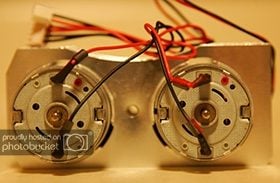
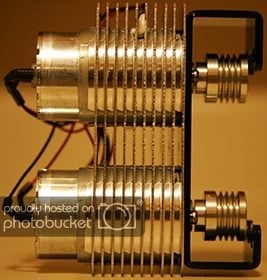
And here is a comparison shot of the stock motor size vs. my replacement motor:
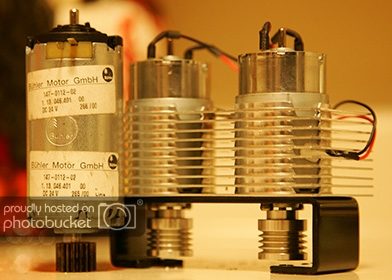
My first mod will involve direct replacement of the OEM Fana-Buchi™ motors with the Bühler motors, as well as a cooling setup for both the motors and the drive MOSFETs. The cooling may not be necessary as-is, but I want to combat the reduction of motor current due to temperature rise that is built into the firmware, as well as gain a bit of headroom so I can overvolt if I still want more power after the motor change.
With the OE motors running at 25.6V I was able to stall the motor just by gripping the motor pulley between my bare thumb and finger and gradually increasing pressure. The motors ran at no load at ~4300RPM at about .06 amps, and stalled were pulling 3.0 amps. The Bühlers ran at no load at ~4200RPM at about .15 amps and stalled pulled about 4.0 amps or a tad more. I found it quite difficult to stall them. They have spur gears on the shaft about the same diameter as the OE motor pulleys. First I tried with gloves and my fingers. No go. I ended up using a block of wood like a lever brake to stall them, and I had to push with darn near all my strength. Should be a significant improvement.
I decided to skip this belt mod since the slippage didn't seem to be very high here. The largest amount seems to occur at the small reduction pulley on the opposite side of the wheel.
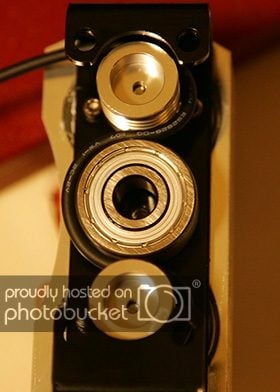
To use the Bühler motors some of the stock parts need to be machined to fit the larger motors. The motors need to have the rear shafts cut down to make them as short as possible and to have flats formed on the shaft on the other end for the pulley setscrews. The pulleys need to be bored or reamed in a metal turning lathe - and it really should be done in a lathe or the pulleys will be eccentric and wobbly, which you can really feel in the wheel (the shaft diameters are different than stock, so the bores must be enlarged). The motor mounts need to be machined to fit the larger motor nose diameter, different bolt spacing and to accept the air cooling parts, and a new wiring harness needs soldered to the motors. You have to watch out here as some of the older wheels used reverse motor polarity to the newer ones. (You'll find out very quickly if you have this reversed as the wheel will turn counterclockwise first when it attempts calibration and will just turn to the lock and stay there. (It should turn clockwise first, then counterclockwise, then clockwise to center-ish).
As of Feb. 2013 I have successfully installed the replacement Bühler motors and have been running them for over a year with no issues that were the fault of the motors. (I did blow a transistor on the PCB but that was due to my toddler twiddling knobs on my power supply while it was off and not checking the voltage before I turned it on. I ended up putting 52VDC into the wheel, blowing out one of the transistors. Replaced and not a problem since). Here is a quick shot of them partially installed from when I first got them in:
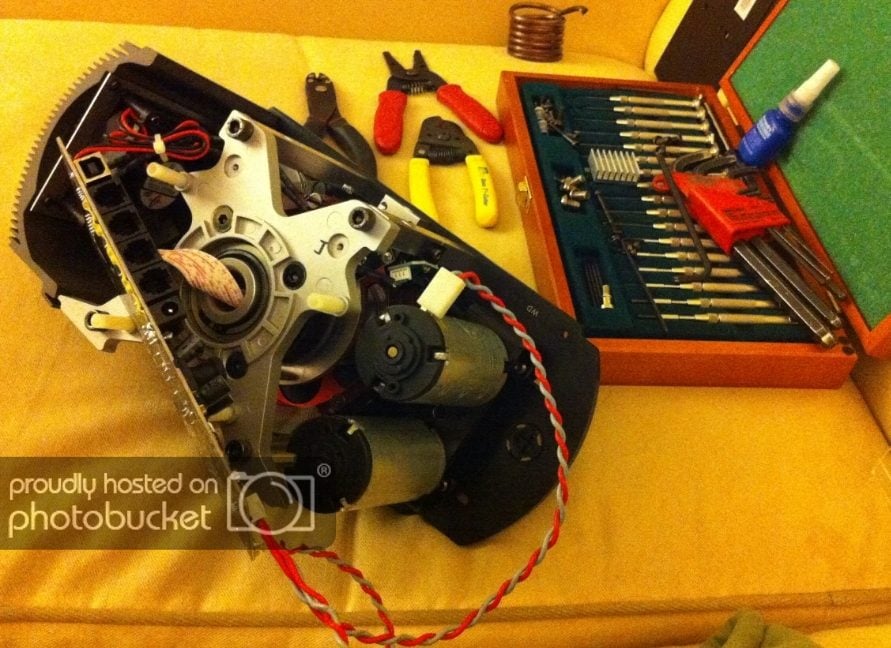
This shows the new longer spacers I made to give the right amount of clearance between the new motors and the PCB:
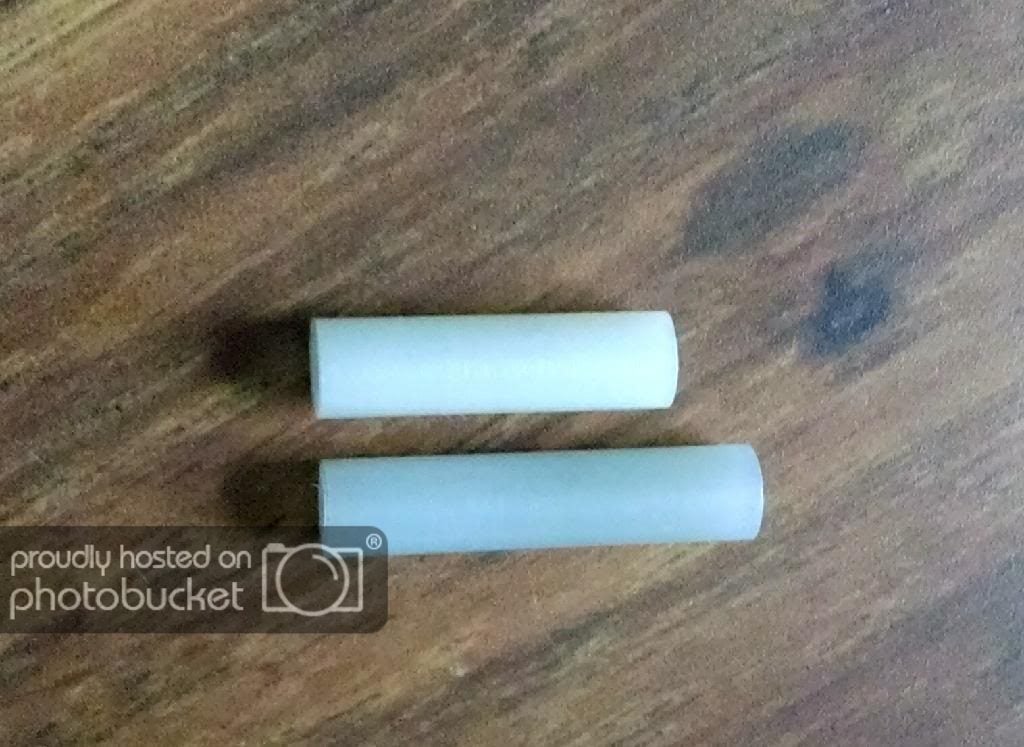

This shows the small gap now visible on top of the housing due to the longer spacers (which personally I don't mind - it lets out more heat!):
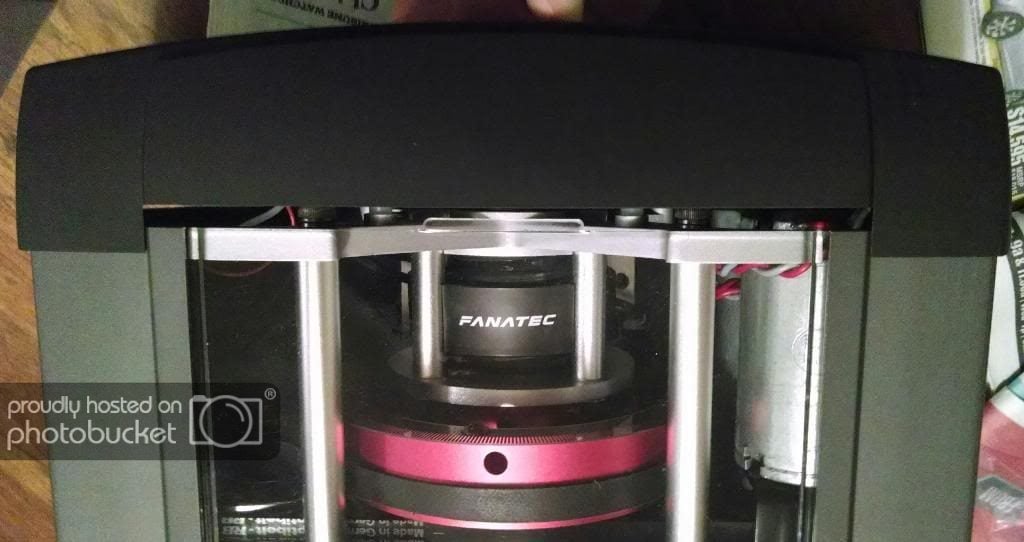
The resultant effect of the stronger motors is as follows:
Stock motors @24VDC pulled 8.5 pounds@~5.38"R. So about 3.8 lbs./ft. (5.2 Nm) of torque.
With the Buhler motors @24VDC pulled 14.5 pounds@~5.38"R. or 6.5lbs./ft. (8.8Nm).
Buhler motors @30VDC pulled 18.25 pounds@~5.38"R. or 8.2lbs./ft. (11.1Nm).
New test:
Buhlers @40VDC pulled 21.25 pounds@~5.38"R. or 9.53lbs./ft. (12.9N•m)
Okeydoke. Just got done reassembling and testing with the stock power supply. I can safely say that it won't work on my wheel with the stock supply at FF100. While it will work during lower FFB, if it hits max torque, it shuts off instantly. I tried racing in F1 2013 also and got shut off several times within a single lap. I then turned down FF to 80 and was able to hit max FFB without shutting down. To check this you have to set SPR to a higher number and crank the wheel. You can't use the 90° SENS method because the soft stops always use full stall current, no matter where you have FF set. So if you run the stock power supply at FF80 and hit the soft stop because your SENS is set lower it will still shut the wheel off.
Now then, when running the stock power supply at FF80, guess what? You STILL get more torque than stock! Great news for everybody - those who don't want super powerful wheels can run their stock power supplies and still get decent power. However I still wouldn't advise this unless you are really tight on funds because you will lose out on some linearity on the bottom end with the weaker forces. With PC sims this can be tuned out pretty easily with the minimum force setting, but for consoles it will chop out some of the weakest forces. So anyways, here are the results:
Bühler motors @24VDC with the stock power supply pulled 11lbs.@~5.38"R. or 4.9lbs./ft. (6.6N•m).
For those familiar with the program Wheel check, this is a graph of the results from my wheel:
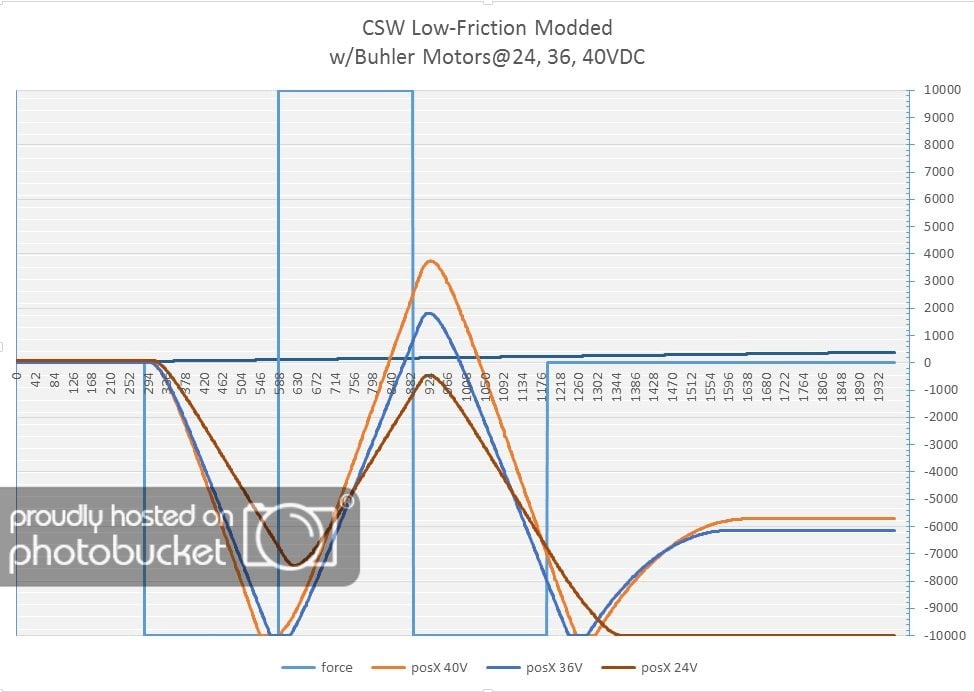
And the linearity graphs from the same program:

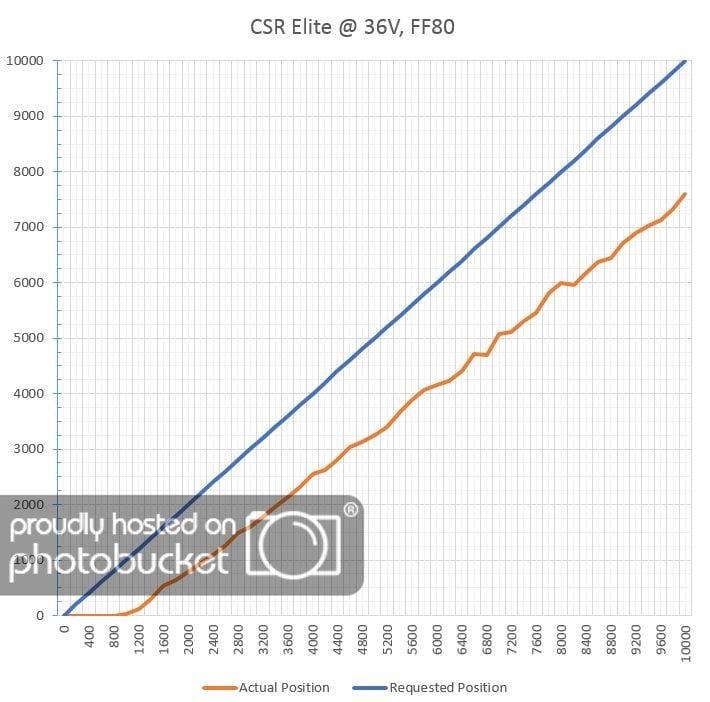
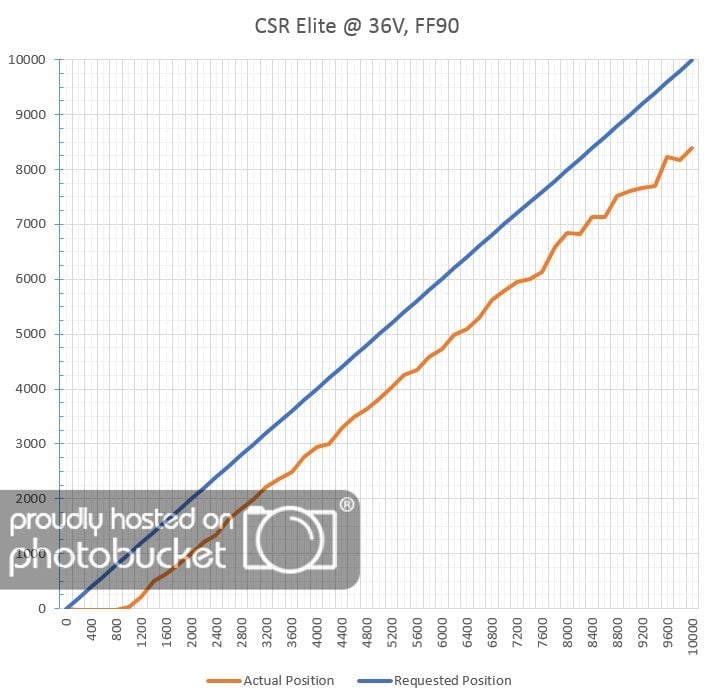
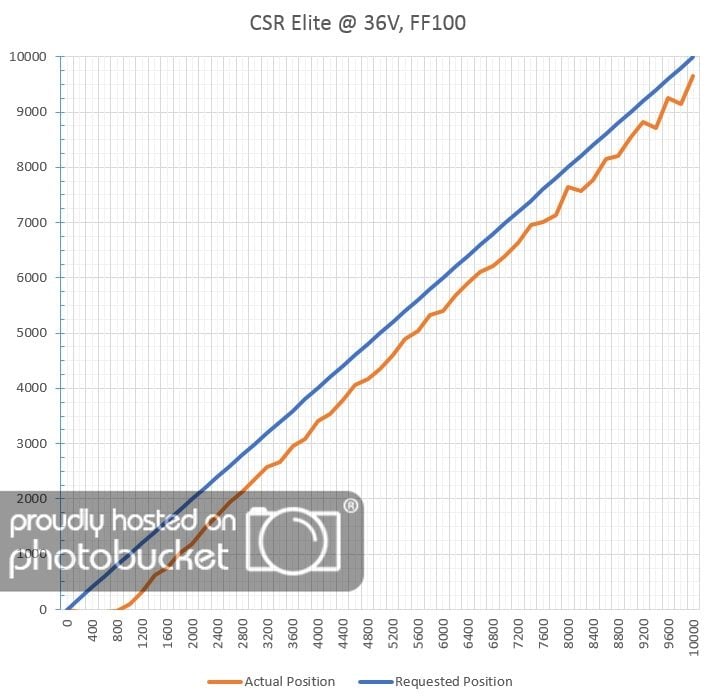
My newest mod effort is to stop the power fade due to heat buildup in the motors using air cooling. Here are my prototype models:

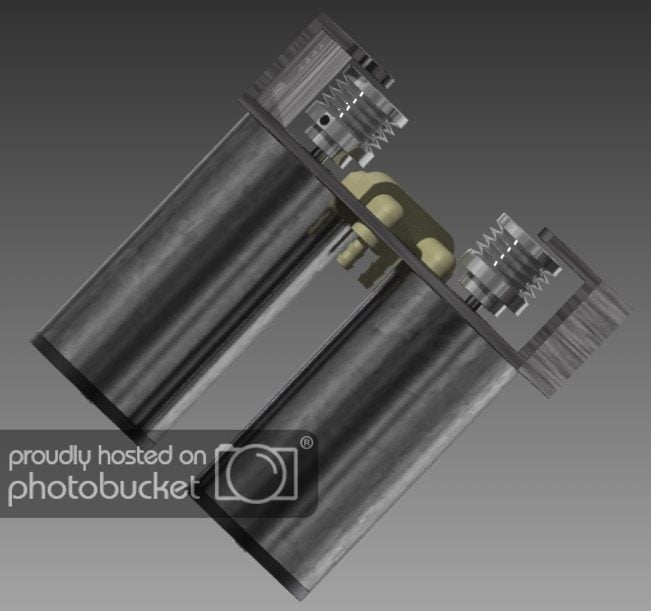
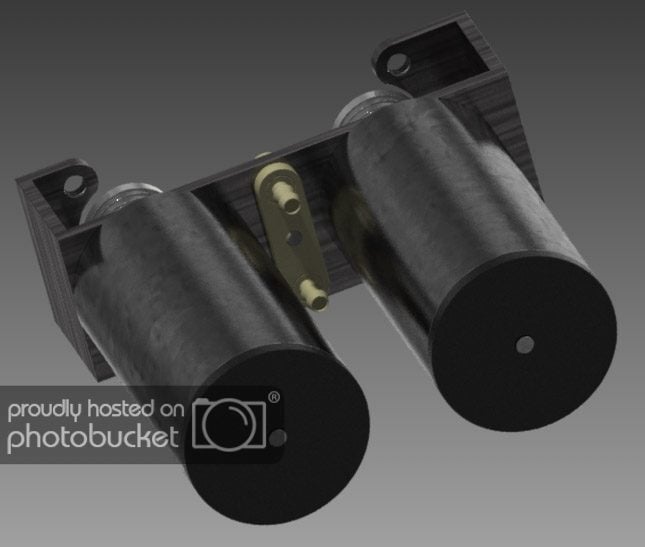
Here's what the complete setup looks like broken down:
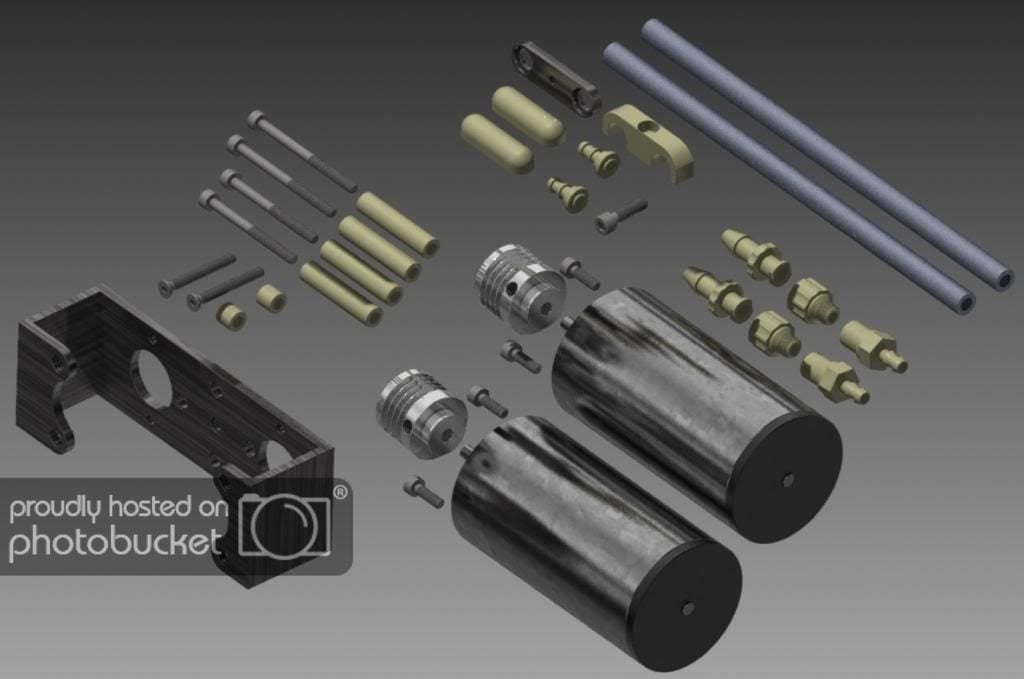
Air will be pumped into the barbed fittings at between 30-40 LPM, the fittings will pass it through holes in the steel motor mount into a small air passage which will carry it over to another set of holes through the motor mount again and into inlet holes that I put into the front endbells of the motors. The air will circulate through the motors carrying away armature and brush heat and brush debris through holes in the rear endbells, after which the stock case fans will evacuate it from the wheel housing.
Further updates after they're finished.
Here's what they look like in the flesh, so to speak, this is a customer's drop-in motor block with new pulleys - I have yet to solder on the motor leads and new plug:
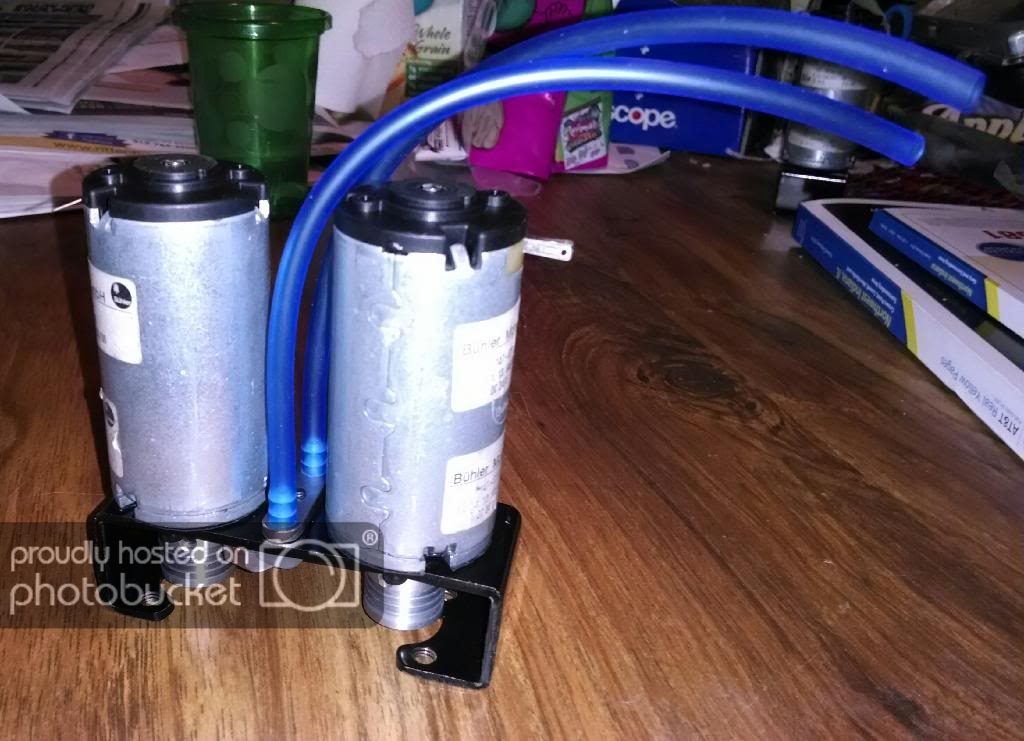
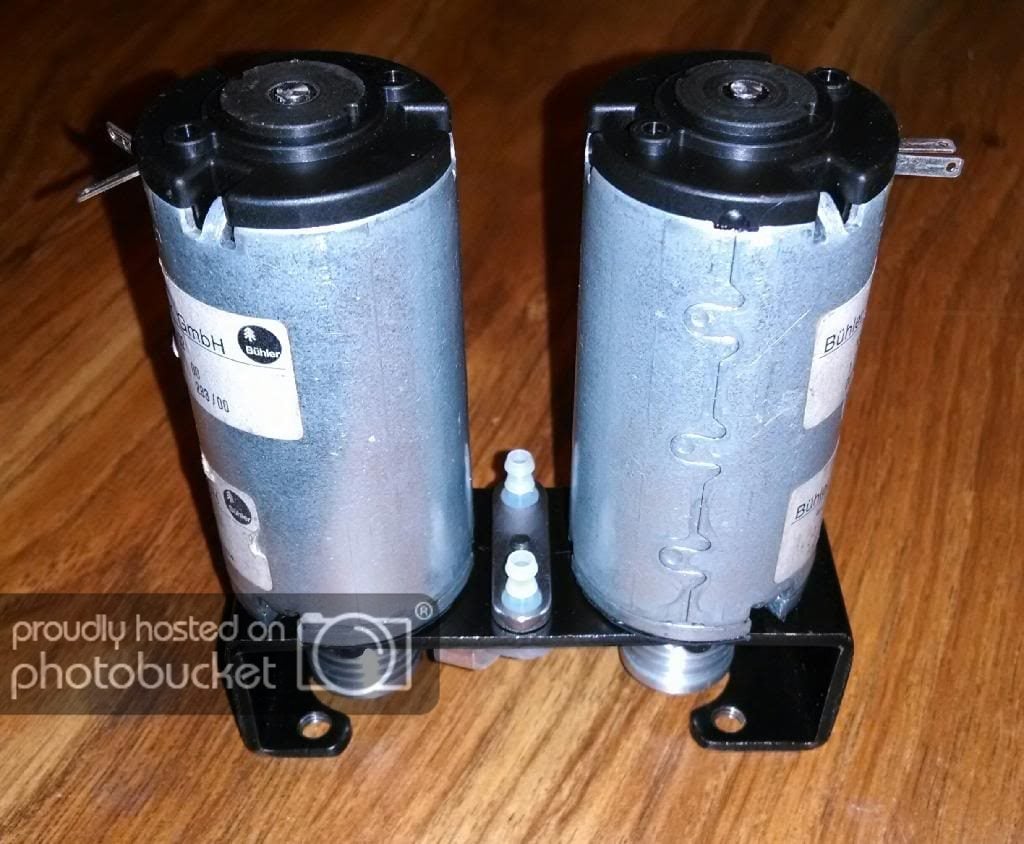
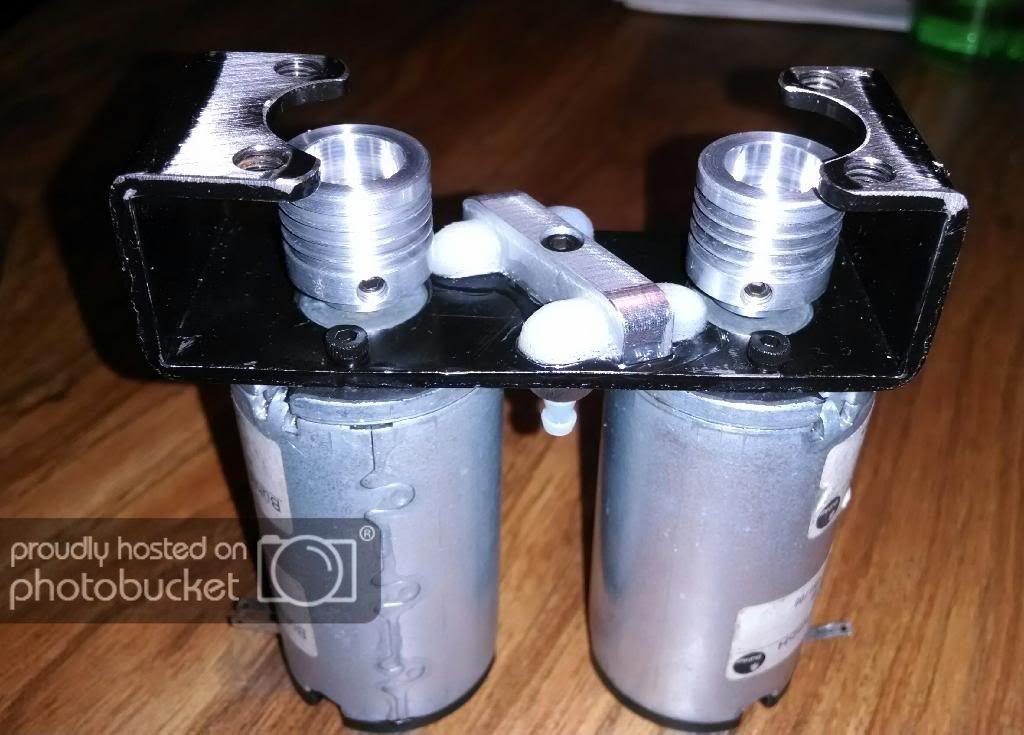
And here's what the wheel looks like when finished. The white fittings are quick release, so the pump is easy and quick to connect and disconnect. I keep my pump behind the TV stand and disconnect the tubing from the wheel and tuck it behind the stand with the pump when not racing:
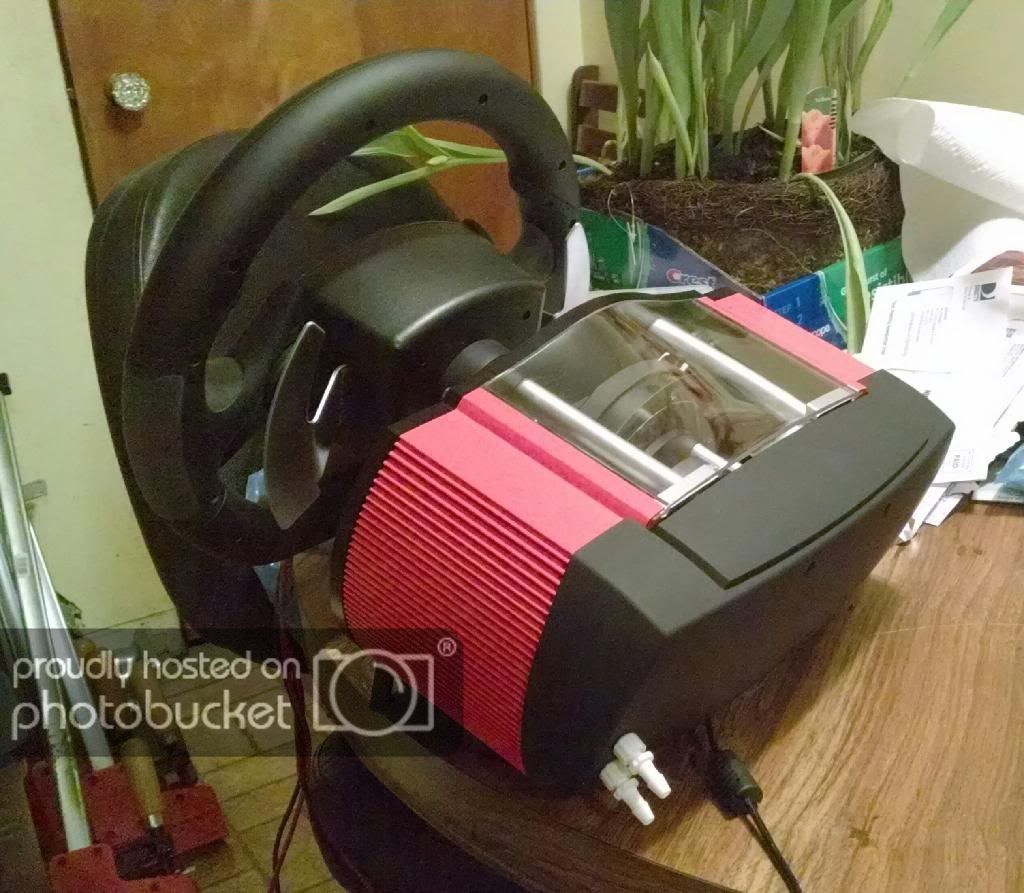
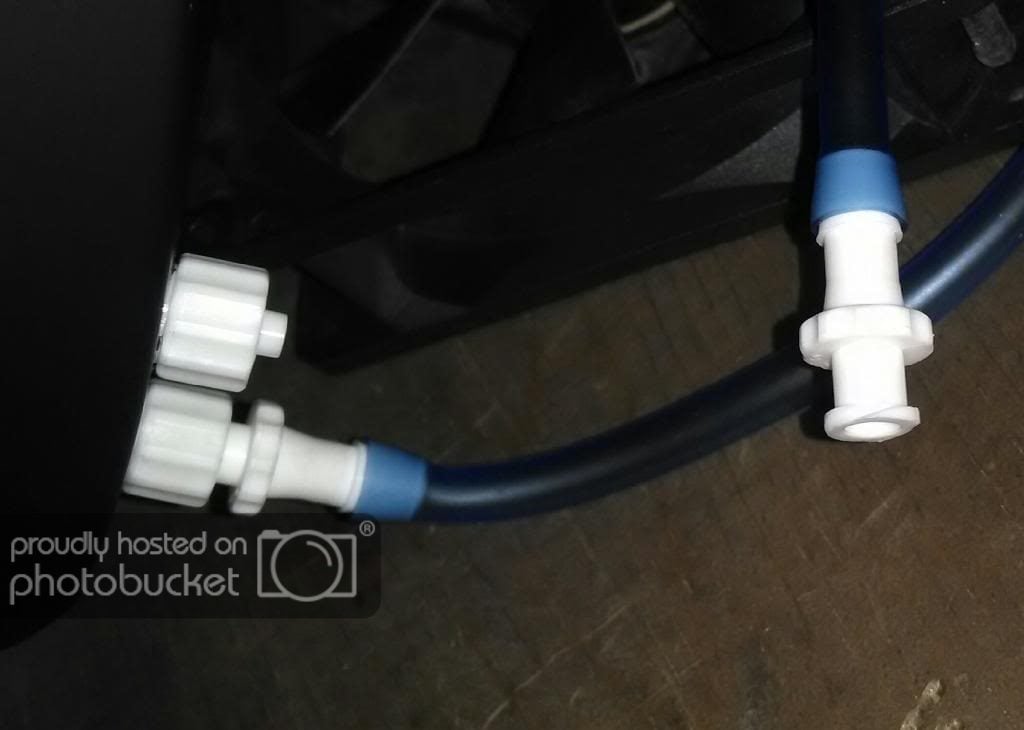
Okay, Ive done some more testing and the air cooling mod is working very well. I've also discovered during my testing that turning the FF setting lower no longer clips the upper range of FFB signals like it did in the original firmware. So if your motors are getting too hot, be they stock or mod, you can now adjust that down with the FF setting without clipping the signal. I am now starting to experiment with some additional cooling tweaks (currently trying out an ice water-to-air intercooler setup) so that overvolting can be safely coped with. I have found that for me, the most awesome feel with the Bühlers is at about 32-36V and FF80-90. This may be way too much power for some guys though.
When I received my new CSW, I noticed some differences from my CSR Elites. Apparently at some point they switched from a 2-rib motor drive belt to a 3-rib belt, and grit-blasted the reduction pulley, as you can see in the following photos.
This is the CSW with the 3-rib belt:
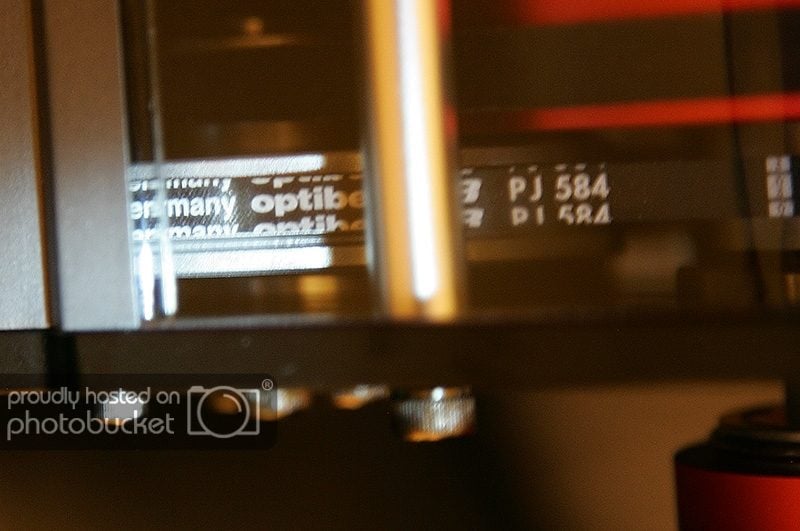
And here is the Elite with the 2-rib belt:

Speaking of the belt mods, there is a Japanese blogger who has tried a few belt mods on his own CSR Elite. Anyone interested should check out the following links:
(Courtesy of GTPlanet member Logi-Force)
This is his blog and he's designing a belt tensioner from here on out for the CSR Elite: http://blogs.yahoo.co.jp/rmjhj650/27431248.html
And a link to when he was further along: http://blogs.yahoo.co.jp/rmjhj650/28520199.html
Oh, and his mountainbike suspension mod on the CSP's: http://blogs.yahoo.co.jp/rmjhj650/29202502.html
Last post is with the CSP MTB mod: http://blogs.yahoo.co.jp/rmjhj650/31377455.html
It appears as though Yosh has made a very nice improvement to the CSR Elite here with a mod that allows interchangeable racing wheels that bolt on with the normal six bolts like real cars. Not quick release but only six small Allen bolts to change the wheel - the electronics stay attached to the hub when the wheel is swapped. Click on the pictures to see; the relevant ones start about half way down the page:
http://m.blogs.yahoo.co.jp/rmjhj650/GALLERY/gallery.html
I will be updating as I make progress with my mods and showing the steps.
I have begun to offer modding services for others using the air cooling setup shown above and Bühler motors. If interested please PM for details and include the options you'd want. If I need to purchase motors, an air pump and/or power supply for you I will request payment up front, otherwise you pay when your parts ship. I can mod your existing pulleys and motor mount or supply a drop-in motor block with cooling setup assembled ready to bolt in. The more you can do yourself the lower the price will be. I recommend sticking to 24V unless you really really want a LOT more power. I am satisfied that the Bühler motors at 24V are pretty much bulletproof. I will install higher voltage power supplies on request but there are no guarantees as far as reliability at higher voltage levels - just like racing parts, cutting edge high power stuff can have a tendency to break or fry. I will say that I have been running my motors at elevated voltages with no problems at all for nearly a year. If you want to run higher voltages I would strongly recommend at minimum either an additional heat sink on the cans or better the use of an intercooling style setup to chill the air going into the motor cans to get every last bit of available cooling possible. Remember that at 36V the motors are capable of pulling nearly 15A at FF100, this means at stall the cooling needs to dissipate over 500 watts of heat! I recommend FF80-FF90 max if overvolting.
*The term "Fana-Buchi™" was coined by GTPlanet member RacerX.
Got a new mod that helps remedy the issues with the stock cable from the quick release connector for the steering wheel to the circuit board. (This cable often gives issues by either rubbing through or breaking and shorting out or coming loose from the back of the quick release plug).
Newest mod: I found a really good item to get rid of the stock crappy coiled cable Fanatec uses down the center of the steering shaft. In industry they use things called rotary junctions or slip rings that have spring-loaded contacts that conduct from one end of the rotary to the other so it can be rotated 360+ degrees but still conduct continuously from one end to the other. This should eliminate a little more drag from the wires coiling and also eliminate the possibility of them rubbing/shorting/breaking due to extended use.
http://www.ebay.com/itm/281282959564?ssPageName=STRK:MEWNX:IT&_trksid=p3984.m1497.l2649
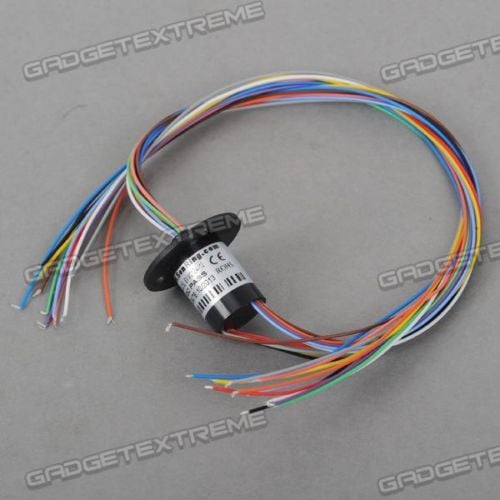

Also video here if you want to see how it works:
http://www.adafruit.com/products/736
I have also outlined some nice friction reducing mods that help improve the feel of the wheel. First thing is changing all the ball bearings from grease to light oil. Another important thing is to make sure the steering shaft bearings don't have excessive preload or "pinch." After that deburr the threaded portion of the shaft that the limiter rides on and switch it also from grease to oil lubrication. Another item I'm working on is lightening my steering shaft pulley, reduction pulley and Formula rim.
As of June 2014 we are starting a group purchase for brand new Bühler motors to get the cost down from over $120 per motor to $75 per motor. This does not include the price of any mod work you might want done.
Motor Group Purchase sign-up form:
https://docs.google.com/forms/d/1q2HmZzm7DD_zaoh83KTxT3A2lYjqeaX75ZdjJmGjSfY/viewform
Most guys go for drop-in motor block which adds $220 to the cost of the motors to complete the mod (you'll need to supply your own power supply, air pump and tubing). This includes all fittings, fasteners, spacers, gaskets, new motor mount, pulleys and wiring harness so you are basically ready to remove your stock motor block and plug in the Bühler motor block.
Here is a link to installation instructions:
http://www.slingfile.com/file/vLryUY882S
Here is a list of additional parts needed to use the drop-in motor block kit:
http://www.slingfile.com/file/sLwf1ncMbW
Here are comments I've received from guys using the mod:
"Even if I have not enough experience I just did 4 laps in AC. 2 with the KTM and 2 with the BMW Z4 GT3 I can say that the feel is very great. I feel more the bumps on the road. The wheel seems more precise and stronger and the extra freewheeling friction is not a problem at all."
"For me it worth any penny invested. I would like to thank you very much for your availability for the speed of your response you kindness and your patience.
THANK YOU"
"1 hour of AC fine tuning FF FFB on wheel and in game I found a setup that is really working for me. I love this mod Eric you did a really great job thank you again!"
"OMG it's like a whole new wheel. Compared to the one I was using ,100% better than that one for sure. I actually think the other base is about to die or they are just that much weaker than the Bühler motors...WOW what a difference. Thank You very much. I will be using it alot more today . One thing I did notice was that I can catch a slide a lot easier with this base compared to the other. The wheel is much "tighter" to turn with the "better" motors which means I can not throw the wheel around ( the FFB is a lot stronger which makes it easier for me to recover a rear end grip slip ).
THANK YOU THANK YOU THANK YOU"
"I did a few laps at Brands Hatch and the wheel is exactly like it was before at FFB70 at FFB 40. It's fracking perfect man. Bravo!
I'll do a little more testing later, post some pics and description in the CSR-E thread and give you some much deserved KUDOS."
"Lastly, I will brag about my experience with Eric. Saying I'm satisfied with Eric's knowledge, patience, hard work and flexibility isn't enough. Sure, I've built many, many PC's in my day. I've soldered a few "chips" before. But I have little to zero experience working with electricity and I think I asked Eric every possible question. And he made sure to answer them and promptly too. I didn't have to wait a week for a reply, always the next day. He told me what to buy, how much/many and recommended tips from his own setup. This is money well spent; a true investment if you are like me and you love your CSR-E/CSW wheel. Yes, the price can be a bit steep, but like anything that is expensive (like an HDTV perhaps), you gotta save up the money or bite the bullet because the pay off on this is huge. Many thanks again Eric!"
"I signed onto GT6 and tried the wheel. The FF was much stronger than it had been with the old stock wheel. It is also a lot smoother. In retrospect I believe the old motors had gradually degraded until they had virtually no force feedback and were also quite "gravelly". The FF is so much stronger then what I was used to I turned it down to 10% in GT6.
I am very happy with the rebuilt wheel. I feel the road much better and can maintain a tighter line through corners. I believe my driving performance will improve. I may or may not increase the FF as I get used to having real force feedback again."
" So I just got the CSW Mod package from Eric, these were rebuilt Buehlers, not the new ones (and I tested in iRacing as that is what I run the most). The mod package is awesome, definitely increases the feeling you get for what the wheels and steering rack are doing. Also since the torque is so much greater there is much less notching as the motors do not have to use 100% of their torque to give you the feeling of bumps and curbs. I have my force set pretty high, and there is no fade at all, WOW is all I can say. The build quality is amazing, to the point that it actually exposed some problems with the build quality of the Fanatec (as the accuracy of Fanatec's mount holes is not 100%, this was not Eric's fault as even my stock motor mount did not fit correctly either). Another hiccup I had was that I had the first version of the CSW base, which means the first time I turned on my wheel it did not work correctly (and a major rise in blood pressure and heart rate). Eric and his great documentation talk about this though (my wheel calibrated the wrong direction at first so failed calibration) and I realized I needed to change my motor polarity which was an easy five minute fix and everything worked great.
I really appreciated Eric's documentation and visuals along with the detailed step by step instructions. While I do not have the base 100% assembled again (as it really does not matter as my cockpit does not expose the wheel base too much and I wanted to be able try it before I make permanent changes to the case) I have enjoyed running lap after lap with it. While it has not made me faster (nothing will, but I do this for the experience, not the gaming), I have to say that it is dramatic the experience I get in the apex of a corner as I can feel even more the wheels falling off in their grip and can catch the back end sliding out (and in the whole process loosing even more momentum speed, thanks Eric!). The advantage of this is a much better learning experience as I can now run a more consistent laps at the limit, or feel where I am pushing an apex by coming in too hot.
I have a Meanwell power supply and the Medo USA pump. The powersupply is great, very quite, the pump is another story, but there are some things to say about it that are not negative. This is a forced pressure ventilation, the pump is kind of loud, not super loud, but enough you do not want to run it when the sim is turned off as it increases the ambient noise. I have mine placed in a closet right next to my sim and the 1/4" vinyl hose running out to my cockpit. This is great for removing the pump noise, but this exposed another source of noise, the air itself!!! The amount of air being forced through the motor housings creates a very noticeable sound of blowing air. One one hand it sounds like a leak, but then it is re-assuring as you KNOW that those big Buehlers are being cooled off. If you are noise sensitive this will be an issue, I have six ButtKickers along with the eight servo's in my GS-4 SimXperience seat plus my 5.1 speakers or Astro headset so I already have a noisy cockpit (and darn it, isn't racing suppose to be loud... unless you are racing a 2014 F1 V6, hehehe).
As I have said the driving is great, this is the best you can do right now compared to a dedicated Servo motor, and as of right now there is only one solution for that and it cost ~$6-7k. I have been lucky enough to try that wheel and while it is in another league, the comparison for force and torque and the ability to pull the wheel violently is MUCH closer. This will still not rip your hands off the wheel so it is not a wrist breaker, but it is an economically viable option until the other anticipated direct servo wheel comes out this fall.
This requires some ability to mod your wheel, and you HAVE to be comfortable taking your wheel apart and hacking it up. I was very confident though as Eric provides some great support and is THE most responsive person I know to emails. You can tell he does this because he loves racing and our hobby/obsession!
One final important note and one I just really noticed why I like high torque wheels (the Bodnar is the perfect example). In many sims, especially iRacing, when you start to lose your steering in a corner two things happen in the sim: 1. the wheels squeal (audio) and 2. the wheel torque falls off dramatically (physical) as the grip of the front tires is lost. In a low torque wheel (CSW is currently the best wheel in the under $1k range) the amount of torque that you loose as your traction falls off is minimal compared to amount of torque you had at the apex or turn in. This results in the feeling that when your front wheels start to lose their grip, you have to REALLY feel it. In higher torque wheels (and I would put Eric's into this category for the upcoming reason), when the front wheels lose their grip in a turn the fall off for the torque is DRAMATIC, which allows you to catch the spin much much sooner than on the lower torque wheels. I know there are aliens out there that by some gift from above can hear a mouse squeak and know that they have gone past the edge of the envelope for their tires, I am not that gifted though. I really appreciate this mod as I can feel the grip of the tires, and more so when I lose that grip and the torque falls off and the wheel I was holding at that perfect angle is now turning even more and I can catch it.
This was a great mod which I have enjoyed very much and think for the price is well worth it!"
Personally, I have had 2 separate incidents of FFB motor failure in my CSR Elites since I received my first in August 2012. The OEM FFB motors are Mabuchi RS555PH designation, and Fanatec has said that they received a bad batch of motors and that is why they're burning out quite often (the "quite often" is my opinion, not something Fanatec has said).
I've discovered a motor that will directly replace the stock motors but isn't any more powerful for those who are looking for them. The motors are designated with a part number of QK1-1500 and are found in select Canon printers from the IP and MP series. If you Google that number some will show up on ebay and a few printer parts sites.
My first action upon having a second set of motors burn up was to buy a pair of Bühler motors, which are used as OE motors in pretty much every vending machine, ATM and similar types of long-life severe service machinery. They are supposed to be dead reliable and very durable. The motors I got, designation 1.13.046.401/404, are slightly larger in diameter, slightly longer, and have 7 poles vs. the stock "Fana-Buchi™"* motors' 5 poles. They are also ball-bearing supported instead of bushed like the Fana-Buchis. The stock motor OD is 1.402" or 35.6mm (although they have a flux ring on the motor that is 1.492" or 37.9mm). My replacement motor OD is 1.572" or 39.9mm, and the T500's motor is 2.031" or 51.6mm.
As far as I can tell by interpolating the graph from the only datasheet I have been able to find for the stock motors, they are rated at 20mN•m of torque and 157mN•m startup and stall at 3.11A. The motors appear to be rated for 8W.
The 1.13.044.236 (the motor in the Thrustmaster T500, also a Bühler motor) are rated at 150mN•m of torque, 100mN•m continuous and 640mN•m startup. The motor is rated for 50W.
The 1.13.046.401/404 (my Bühler motors) are rated at 60mN•m of torque, 45mN•m continuous and 290mN•m startup. (So in Fanatec's dual-motor config, you'd basically double those to 120mN•m, 90mN•m, and 580mN•m). These motors are rated for 15W. By using these motors, I should effectively be getting about the same strength at the motors as the T500, which could vary at the wheel depending on the gear ratio difference, and considerably stronger at the motor if I go the overvolting route.
Also, for those who have never really seen them, here's a little better view of the stock FFB motors:


And here is a comparison shot of the stock motor size vs. my replacement motor:

My first mod will involve direct replacement of the OEM Fana-Buchi™ motors with the Bühler motors, as well as a cooling setup for both the motors and the drive MOSFETs. The cooling may not be necessary as-is, but I want to combat the reduction of motor current due to temperature rise that is built into the firmware, as well as gain a bit of headroom so I can overvolt if I still want more power after the motor change.
With the OE motors running at 25.6V I was able to stall the motor just by gripping the motor pulley between my bare thumb and finger and gradually increasing pressure. The motors ran at no load at ~4300RPM at about .06 amps, and stalled were pulling 3.0 amps. The Bühlers ran at no load at ~4200RPM at about .15 amps and stalled pulled about 4.0 amps or a tad more. I found it quite difficult to stall them. They have spur gears on the shaft about the same diameter as the OE motor pulleys. First I tried with gloves and my fingers. No go. I ended up using a block of wood like a lever brake to stall them, and I had to push with darn near all my strength. Should be a significant improvement.
I decided to skip this belt mod since the slippage didn't seem to be very high here. The largest amount seems to occur at the small reduction pulley on the opposite side of the wheel.

To use the Bühler motors some of the stock parts need to be machined to fit the larger motors. The motors need to have the rear shafts cut down to make them as short as possible and to have flats formed on the shaft on the other end for the pulley setscrews. The pulleys need to be bored or reamed in a metal turning lathe - and it really should be done in a lathe or the pulleys will be eccentric and wobbly, which you can really feel in the wheel (the shaft diameters are different than stock, so the bores must be enlarged). The motor mounts need to be machined to fit the larger motor nose diameter, different bolt spacing and to accept the air cooling parts, and a new wiring harness needs soldered to the motors. You have to watch out here as some of the older wheels used reverse motor polarity to the newer ones. (You'll find out very quickly if you have this reversed as the wheel will turn counterclockwise first when it attempts calibration and will just turn to the lock and stay there. (It should turn clockwise first, then counterclockwise, then clockwise to center-ish).
As of Feb. 2013 I have successfully installed the replacement Bühler motors and have been running them for over a year with no issues that were the fault of the motors. (I did blow a transistor on the PCB but that was due to my toddler twiddling knobs on my power supply while it was off and not checking the voltage before I turned it on. I ended up putting 52VDC into the wheel, blowing out one of the transistors. Replaced and not a problem since). Here is a quick shot of them partially installed from when I first got them in:

This shows the new longer spacers I made to give the right amount of clearance between the new motors and the PCB:


This shows the small gap now visible on top of the housing due to the longer spacers (which personally I don't mind - it lets out more heat!):

The resultant effect of the stronger motors is as follows:
Stock motors @24VDC pulled 8.5 pounds@~5.38"R. So about 3.8 lbs./ft. (5.2 Nm) of torque.
With the Buhler motors @24VDC pulled 14.5 pounds@~5.38"R. or 6.5lbs./ft. (8.8Nm).
Buhler motors @30VDC pulled 18.25 pounds@~5.38"R. or 8.2lbs./ft. (11.1Nm).
New test:
Buhlers @40VDC pulled 21.25 pounds@~5.38"R. or 9.53lbs./ft. (12.9N•m)
Okeydoke. Just got done reassembling and testing with the stock power supply. I can safely say that it won't work on my wheel with the stock supply at FF100. While it will work during lower FFB, if it hits max torque, it shuts off instantly. I tried racing in F1 2013 also and got shut off several times within a single lap. I then turned down FF to 80 and was able to hit max FFB without shutting down. To check this you have to set SPR to a higher number and crank the wheel. You can't use the 90° SENS method because the soft stops always use full stall current, no matter where you have FF set. So if you run the stock power supply at FF80 and hit the soft stop because your SENS is set lower it will still shut the wheel off.
Now then, when running the stock power supply at FF80, guess what? You STILL get more torque than stock! Great news for everybody - those who don't want super powerful wheels can run their stock power supplies and still get decent power. However I still wouldn't advise this unless you are really tight on funds because you will lose out on some linearity on the bottom end with the weaker forces. With PC sims this can be tuned out pretty easily with the minimum force setting, but for consoles it will chop out some of the weakest forces. So anyways, here are the results:
Bühler motors @24VDC with the stock power supply pulled 11lbs.@~5.38"R. or 4.9lbs./ft. (6.6N•m).
For those familiar with the program Wheel check, this is a graph of the results from my wheel:

And the linearity graphs from the same program:




My newest mod effort is to stop the power fade due to heat buildup in the motors using air cooling. Here are my prototype models:



Here's what the complete setup looks like broken down:

Air will be pumped into the barbed fittings at between 30-40 LPM, the fittings will pass it through holes in the steel motor mount into a small air passage which will carry it over to another set of holes through the motor mount again and into inlet holes that I put into the front endbells of the motors. The air will circulate through the motors carrying away armature and brush heat and brush debris through holes in the rear endbells, after which the stock case fans will evacuate it from the wheel housing.
Further updates after they're finished.
Here's what they look like in the flesh, so to speak, this is a customer's drop-in motor block with new pulleys - I have yet to solder on the motor leads and new plug:



And here's what the wheel looks like when finished. The white fittings are quick release, so the pump is easy and quick to connect and disconnect. I keep my pump behind the TV stand and disconnect the tubing from the wheel and tuck it behind the stand with the pump when not racing:


Okay, Ive done some more testing and the air cooling mod is working very well. I've also discovered during my testing that turning the FF setting lower no longer clips the upper range of FFB signals like it did in the original firmware. So if your motors are getting too hot, be they stock or mod, you can now adjust that down with the FF setting without clipping the signal. I am now starting to experiment with some additional cooling tweaks (currently trying out an ice water-to-air intercooler setup) so that overvolting can be safely coped with. I have found that for me, the most awesome feel with the Bühlers is at about 32-36V and FF80-90. This may be way too much power for some guys though.
When I received my new CSW, I noticed some differences from my CSR Elites. Apparently at some point they switched from a 2-rib motor drive belt to a 3-rib belt, and grit-blasted the reduction pulley, as you can see in the following photos.
This is the CSW with the 3-rib belt:

And here is the Elite with the 2-rib belt:

Speaking of the belt mods, there is a Japanese blogger who has tried a few belt mods on his own CSR Elite. Anyone interested should check out the following links:
(Courtesy of GTPlanet member Logi-Force)
This is his blog and he's designing a belt tensioner from here on out for the CSR Elite: http://blogs.yahoo.co.jp/rmjhj650/27431248.html
And a link to when he was further along: http://blogs.yahoo.co.jp/rmjhj650/28520199.html
Oh, and his mountainbike suspension mod on the CSP's: http://blogs.yahoo.co.jp/rmjhj650/29202502.html
Last post is with the CSP MTB mod: http://blogs.yahoo.co.jp/rmjhj650/31377455.html
It appears as though Yosh has made a very nice improvement to the CSR Elite here with a mod that allows interchangeable racing wheels that bolt on with the normal six bolts like real cars. Not quick release but only six small Allen bolts to change the wheel - the electronics stay attached to the hub when the wheel is swapped. Click on the pictures to see; the relevant ones start about half way down the page:
http://m.blogs.yahoo.co.jp/rmjhj650/GALLERY/gallery.html
I will be updating as I make progress with my mods and showing the steps.
I have begun to offer modding services for others using the air cooling setup shown above and Bühler motors. If interested please PM for details and include the options you'd want. If I need to purchase motors, an air pump and/or power supply for you I will request payment up front, otherwise you pay when your parts ship. I can mod your existing pulleys and motor mount or supply a drop-in motor block with cooling setup assembled ready to bolt in. The more you can do yourself the lower the price will be. I recommend sticking to 24V unless you really really want a LOT more power. I am satisfied that the Bühler motors at 24V are pretty much bulletproof. I will install higher voltage power supplies on request but there are no guarantees as far as reliability at higher voltage levels - just like racing parts, cutting edge high power stuff can have a tendency to break or fry. I will say that I have been running my motors at elevated voltages with no problems at all for nearly a year. If you want to run higher voltages I would strongly recommend at minimum either an additional heat sink on the cans or better the use of an intercooling style setup to chill the air going into the motor cans to get every last bit of available cooling possible. Remember that at 36V the motors are capable of pulling nearly 15A at FF100, this means at stall the cooling needs to dissipate over 500 watts of heat! I recommend FF80-FF90 max if overvolting.
*The term "Fana-Buchi™" was coined by GTPlanet member RacerX.
Got a new mod that helps remedy the issues with the stock cable from the quick release connector for the steering wheel to the circuit board. (This cable often gives issues by either rubbing through or breaking and shorting out or coming loose from the back of the quick release plug).
Newest mod: I found a really good item to get rid of the stock crappy coiled cable Fanatec uses down the center of the steering shaft. In industry they use things called rotary junctions or slip rings that have spring-loaded contacts that conduct from one end of the rotary to the other so it can be rotated 360+ degrees but still conduct continuously from one end to the other. This should eliminate a little more drag from the wires coiling and also eliminate the possibility of them rubbing/shorting/breaking due to extended use.
http://www.ebay.com/itm/281282959564?ssPageName=STRK:MEWNX:IT&_trksid=p3984.m1497.l2649


Also video here if you want to see how it works:
http://www.adafruit.com/products/736
I have also outlined some nice friction reducing mods that help improve the feel of the wheel. First thing is changing all the ball bearings from grease to light oil. Another important thing is to make sure the steering shaft bearings don't have excessive preload or "pinch." After that deburr the threaded portion of the shaft that the limiter rides on and switch it also from grease to oil lubrication. Another item I'm working on is lightening my steering shaft pulley, reduction pulley and Formula rim.
As of June 2014 we are starting a group purchase for brand new Bühler motors to get the cost down from over $120 per motor to $75 per motor. This does not include the price of any mod work you might want done.
Motor Group Purchase sign-up form:
https://docs.google.com/forms/d/1q2HmZzm7DD_zaoh83KTxT3A2lYjqeaX75ZdjJmGjSfY/viewform
Most guys go for drop-in motor block which adds $220 to the cost of the motors to complete the mod (you'll need to supply your own power supply, air pump and tubing). This includes all fittings, fasteners, spacers, gaskets, new motor mount, pulleys and wiring harness so you are basically ready to remove your stock motor block and plug in the Bühler motor block.
Here is a link to installation instructions:
http://www.slingfile.com/file/vLryUY882S
Here is a list of additional parts needed to use the drop-in motor block kit:
http://www.slingfile.com/file/sLwf1ncMbW
Here are comments I've received from guys using the mod:
"Even if I have not enough experience I just did 4 laps in AC. 2 with the KTM and 2 with the BMW Z4 GT3 I can say that the feel is very great. I feel more the bumps on the road. The wheel seems more precise and stronger and the extra freewheeling friction is not a problem at all."
"For me it worth any penny invested. I would like to thank you very much for your availability for the speed of your response you kindness and your patience.
THANK YOU"
"1 hour of AC fine tuning FF FFB on wheel and in game I found a setup that is really working for me. I love this mod Eric you did a really great job thank you again!"
"OMG it's like a whole new wheel. Compared to the one I was using ,100% better than that one for sure. I actually think the other base is about to die or they are just that much weaker than the Bühler motors...WOW what a difference. Thank You very much. I will be using it alot more today . One thing I did notice was that I can catch a slide a lot easier with this base compared to the other. The wheel is much "tighter" to turn with the "better" motors which means I can not throw the wheel around ( the FFB is a lot stronger which makes it easier for me to recover a rear end grip slip ).
THANK YOU THANK YOU THANK YOU"
"I did a few laps at Brands Hatch and the wheel is exactly like it was before at FFB70 at FFB 40. It's fracking perfect man. Bravo!
I'll do a little more testing later, post some pics and description in the CSR-E thread and give you some much deserved KUDOS."
"Lastly, I will brag about my experience with Eric. Saying I'm satisfied with Eric's knowledge, patience, hard work and flexibility isn't enough. Sure, I've built many, many PC's in my day. I've soldered a few "chips" before. But I have little to zero experience working with electricity and I think I asked Eric every possible question. And he made sure to answer them and promptly too. I didn't have to wait a week for a reply, always the next day. He told me what to buy, how much/many and recommended tips from his own setup. This is money well spent; a true investment if you are like me and you love your CSR-E/CSW wheel. Yes, the price can be a bit steep, but like anything that is expensive (like an HDTV perhaps), you gotta save up the money or bite the bullet because the pay off on this is huge. Many thanks again Eric!"
"I signed onto GT6 and tried the wheel. The FF was much stronger than it had been with the old stock wheel. It is also a lot smoother. In retrospect I believe the old motors had gradually degraded until they had virtually no force feedback and were also quite "gravelly". The FF is so much stronger then what I was used to I turned it down to 10% in GT6.
I am very happy with the rebuilt wheel. I feel the road much better and can maintain a tighter line through corners. I believe my driving performance will improve. I may or may not increase the FF as I get used to having real force feedback again."
" So I just got the CSW Mod package from Eric, these were rebuilt Buehlers, not the new ones (and I tested in iRacing as that is what I run the most). The mod package is awesome, definitely increases the feeling you get for what the wheels and steering rack are doing. Also since the torque is so much greater there is much less notching as the motors do not have to use 100% of their torque to give you the feeling of bumps and curbs. I have my force set pretty high, and there is no fade at all, WOW is all I can say. The build quality is amazing, to the point that it actually exposed some problems with the build quality of the Fanatec (as the accuracy of Fanatec's mount holes is not 100%, this was not Eric's fault as even my stock motor mount did not fit correctly either). Another hiccup I had was that I had the first version of the CSW base, which means the first time I turned on my wheel it did not work correctly (and a major rise in blood pressure and heart rate). Eric and his great documentation talk about this though (my wheel calibrated the wrong direction at first so failed calibration) and I realized I needed to change my motor polarity which was an easy five minute fix and everything worked great.
I really appreciated Eric's documentation and visuals along with the detailed step by step instructions. While I do not have the base 100% assembled again (as it really does not matter as my cockpit does not expose the wheel base too much and I wanted to be able try it before I make permanent changes to the case) I have enjoyed running lap after lap with it. While it has not made me faster (nothing will, but I do this for the experience, not the gaming), I have to say that it is dramatic the experience I get in the apex of a corner as I can feel even more the wheels falling off in their grip and can catch the back end sliding out (and in the whole process loosing even more momentum speed, thanks Eric!). The advantage of this is a much better learning experience as I can now run a more consistent laps at the limit, or feel where I am pushing an apex by coming in too hot.
I have a Meanwell power supply and the Medo USA pump. The powersupply is great, very quite, the pump is another story, but there are some things to say about it that are not negative. This is a forced pressure ventilation, the pump is kind of loud, not super loud, but enough you do not want to run it when the sim is turned off as it increases the ambient noise. I have mine placed in a closet right next to my sim and the 1/4" vinyl hose running out to my cockpit. This is great for removing the pump noise, but this exposed another source of noise, the air itself!!! The amount of air being forced through the motor housings creates a very noticeable sound of blowing air. One one hand it sounds like a leak, but then it is re-assuring as you KNOW that those big Buehlers are being cooled off. If you are noise sensitive this will be an issue, I have six ButtKickers along with the eight servo's in my GS-4 SimXperience seat plus my 5.1 speakers or Astro headset so I already have a noisy cockpit (and darn it, isn't racing suppose to be loud... unless you are racing a 2014 F1 V6, hehehe).
As I have said the driving is great, this is the best you can do right now compared to a dedicated Servo motor, and as of right now there is only one solution for that and it cost ~$6-7k. I have been lucky enough to try that wheel and while it is in another league, the comparison for force and torque and the ability to pull the wheel violently is MUCH closer. This will still not rip your hands off the wheel so it is not a wrist breaker, but it is an economically viable option until the other anticipated direct servo wheel comes out this fall.
This requires some ability to mod your wheel, and you HAVE to be comfortable taking your wheel apart and hacking it up. I was very confident though as Eric provides some great support and is THE most responsive person I know to emails. You can tell he does this because he loves racing and our hobby/obsession!
One final important note and one I just really noticed why I like high torque wheels (the Bodnar is the perfect example). In many sims, especially iRacing, when you start to lose your steering in a corner two things happen in the sim: 1. the wheels squeal (audio) and 2. the wheel torque falls off dramatically (physical) as the grip of the front tires is lost. In a low torque wheel (CSW is currently the best wheel in the under $1k range) the amount of torque that you loose as your traction falls off is minimal compared to amount of torque you had at the apex or turn in. This results in the feeling that when your front wheels start to lose their grip, you have to REALLY feel it. In higher torque wheels (and I would put Eric's into this category for the upcoming reason), when the front wheels lose their grip in a turn the fall off for the torque is DRAMATIC, which allows you to catch the spin much much sooner than on the lower torque wheels. I know there are aliens out there that by some gift from above can hear a mouse squeak and know that they have gone past the edge of the envelope for their tires, I am not that gifted though. I really appreciate this mod as I can feel the grip of the tires, and more so when I lose that grip and the torque falls off and the wheel I was holding at that perfect angle is now turning even more and I can catch it.
This was a great mod which I have enjoyed very much and think for the price is well worth it!"
Last edited:

